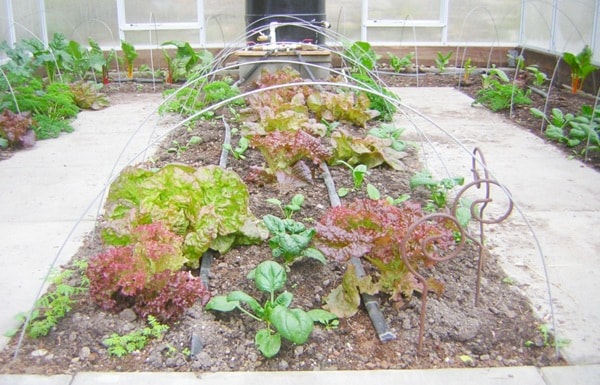Growing fresh produce through the winter sounds like it should be impossible — or difficult, at the very least — but a two-year project at the College of the Rockies’ community greenhouse proved that it can be done.
Funded by the Columbia Basin Trust and Investment Agriculture Foundation of BC, the project was inspired by the book Four-Season Harvest by Elliot Coleman.
“Nobody really grows anything in the winter,” said winter harvest co-ordinator Karen Powis. “Gardeners grow things to end in August or September and then quit. Some people are aware of an extended season.”
From March 2009 through February 2011, a total of nearly 50 gardeners — 34 in the first year and 37 in the second, with several overlapping — participated in the experiment, in which they grew cold-hardy vegetables in unheated beds and greenhouses of their own creation.
“Every single person came up with some sort of environment,” said Powis. “Some were simple and some were complex.”
Beds ranged from a simple one-dimensional frame with plastic draped over it — resembling a pup tent — to Rubbermaid storage bins to homemade raised beds. An excellent fall crop grew in a mini-greenhouse, but it was lost when winter winds blew the doors off.
“The simplest way is to plant cold-hardy vegetables in the garden, then in October cover them with wire hoops or floating row covers,” said Powis.
In the first season, Powis — who already had experience overwintering onions when she lived in Calgary — used a four-by-four-foot cold frame with a base made out of hay bales with old shower doors on top.
Among the crops attempted over the winter were spinach, kale, carrots, beets, turnips, arugula, lettuce and chard. Most grew well, particularly spinach when a grow light was added to the mix for six hours a day — that spinach grew three to fours times bigger than the rest.
“It’s the biggest and most beautiful I’ve ever seen,” said Powis.
Among the gardeners who took part was a commercial grower who tried a spinach crop. Powis felt the success could be parlayed into something bigger.
“I’m really hoping they get into growing spinach,” she said. “They could have a really good season selling it.”
Throughout the experiment, gardeners met once a month to share tips and report on progress. The biggest shock for most was that the premise of the experiment was sound.
“Everyone has something different to share,” said Powis. “The surprise was that if you plant cold-hardy vegetables in the fall, they grow really well. They’re shocked at how much food they can grow, especially in the fall. And these are experienced gardeners!”
One similarity to summer gardening is many gardeners’ least favourite: pests. These included the cabbage butterfly caterpillar and flea beetle, although the gardeners took it in stride.
“They see all the green stuff in there and think, ‘Salad bar,’ ” Powis said. “It didn’t seem to deter anyone.”
With the exception of monthly meetings, gardeners worked alone for the most part, planting crops on Aug. 15, covering them in October and watching their progress through the winter. Around December, the progress of most slowed to a crawl as the plants went dormant, but in February they began growing again.
Through most of the season, the weather helps to keep tending the crop from taking up much time.
“There’s really not much work in the winter,” Powis said. “You don’t really have to go out and water.”
She hopes that the positive results and extensive documentation help others, both private and commercial growers, to continue winter growing, adding to the range of local food products available in the Creston Valley.
“It’s going to go a long way toward increasing food security in the area,” said Powis.
For more on the winter harvest project, read the blog at www.communitygreenhouse.blogspot.com.
